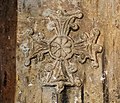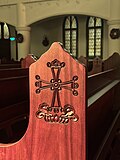- Nestorian headstone
- Nestorian cross found in China
- Nestorian cross found in China
- Two Nestorian crosses found in China
- The cross from the Nestorian Stele
- Nestorian altar-type grave monument shows a stone grave marker with cross symbol on its flat top
- Saint Thomas Christian cross from India
- Nestorian headstone rubbing with cross-on-lotus symbol
- Rubbing of a Nestorian cross at the Cross Temple, Fangshan
- Rubbing of a Nestorian cross at the Cross Temple, Fangshan
- Cross in the headdress of a Christian figure, detail of the Mogao Christian painting, 9th century.
- Relief of a cross at Rabban Hormizd Monastery
- Yuan dynasty stone-carved Nestorian cross from Cross Temple, Fangshan, Beijing (then called Khanbaliq)
- Modern rendition of the Nestorian Cross at Huizhong Church, Shanghai
This article needs additional citations for verification .(July 2013) |

The Nestorian cross is associated with the Church of the East. It is composed of a cross similar to the Maltese cross, with four arms of roughly equal length which narrow in width towards the center of the cross. In Eastern Christian art in China, these crosses are sometimes simplified and depicted as resting on a lotus flower or on a stylized cloud.














